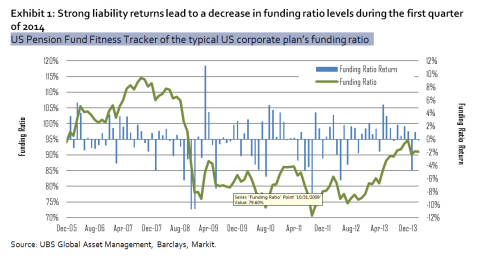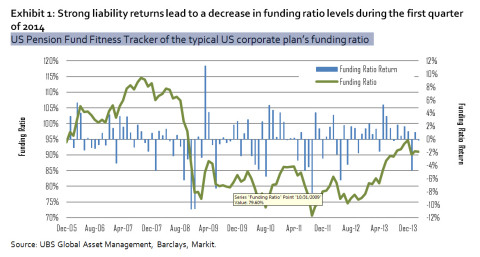CHICAGO--(BUSINESS WIRE)--The UBS Global Asset Management US Pension Fund Fitness Tracker saw the funding ratio of the typical corporate US pension plan drop by approximately four percentage points to 91% in the first quarter of 2014.
"After a 17% funding ratio improvement in 2013, we believe that the 4% decline in the first quarter of 2014 should serve as a catalyst for plan sponsors to proactively protect their gains by adding to their hedging/de-risking program" said Robert Guzman, Head of Pension Risk Management at UBS Global Asset Management.
Investment returns of 2.1% could not offset the 6.1% increase in liability values, causing pension plans to give back some of the gains made in 2013. These estimates are based on the average corporate plan’s reported asset allocation weightings from the UBS Global Asset Management Pension 500 Database and publicly available benchmark information.
During the first quarter, the S&P 500 Index recorded a 1.81% total return. In January, currency weakness in several emerging markets dominated the headlines, prompting the central banks of Turkey, South Africa and India to hike their interest rates. The situation in Ukraine deteriorated, but has not weighted on equity markets yet. In the US, Janet Yellen, the new Chair of the US Federal Reserve (Fed), held her first press conference and signaled the potential for earlier-than-expected interest rate hikes. The European Central Bank (ECB) decided to keep the policy rate at 0.25%, surprising many market participants that expected a rate cut given the price inflation level below its stated medium-term target of 2%. In US dollar (USD) terms, the Euro Stoxx Total Return Index was up 3.25% over the quarter. After a strong negative return in January, the MSCI Emerging Markets Total Return Index rebounded slightly, ending the quarter down 0.37% in USD terms.
After a volatile quarter, the yield on 10-year US Treasury bonds decreased by 31 basis points (bps), ending at 2.72%. The yield on 30-year US Treasury bonds decreased 41 bps, ending at 3.56%. High-quality corporate bond credit spreads, as measured by the Barclays Capital Long Credit A+ option-adjusted spread, ended the quarter 2 bps tighter. As a result, pension discount rates (which are based on the yield of high-quality investment grade corporate bonds) decreased over the quarter. The passage of time caused liabilities for a typical pension plan to increase by about one percentage point over the quarter. Together, these effects caused liabilities to increase 6.1% for the quarter. (Please see disclosures for assumptions and methodology.)
Disclosures and methodology
Funding ratio
Funding ratios measure a pension fund’s ability to meet future payout obligations to plan participants. The main factors impacting the funding ratio of a typical US defined benefit plan are equity market returns, which grow (or shrink) the asset pool from which plan participants’ benefits are paid, and liability returns, which move inversely to interest rates.
Liability indices: Methodology
Pension Protection Act (PPA) liability returns are approximated by the Barclays Capital US Long Credit A-AAA Index. This index broadly reflects the duration and credit characteristics of the PPA discount curve that is used to discount expected pension benefit payments for US defined benefit pension plans.
Asset index: Methodology
UBS Global Asset Management approximates the return for the ”typical” US defined benefit plan using the reported asset allocation of the UBS Global Asset Management Pension 500 Database. The series is constructed using the aggregate asset allocation weightings and publicly available benchmark information, with geometrically linked monthly total returns.
Pension Fund Fitness Tracker: Methodology
The US Pension Fund Fitness Tracker is the ratio of the asset index over the liability index. Assuming all other factors remain constant, it combines asset and liability returns and measures the impact of a “typical” investment strategy on the funding ratio of a model defined benefit plan in the US due to interest rollup, change in interest rates and typical asset performance, but excludes unique plan factors, such as service cost and benefit payments.
The UBS Global Asset Management Pension 500 Database
The UBS Global Asset Management Pension 500 Database is a proprietary database that is based on the analysis of 500 public companies sponsoring large defined benefit plans. The information was extracted from the companies’ 10-K statements. The study may include figures for companies’ nonqualified and foreign plans, both of which are not subject to ERISA.
The aggregate asset allocation is based on an equally weighted average of the 500 companies included in the database. The aggregate asset allocation includes equities, fixed income, hedge funds, private equity, real estate and cash.




